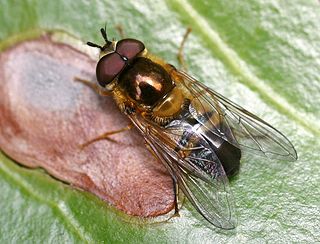Related Research Articles

Paragus is a genus of hoverflies.

The Therevidae are a family of flies of the superfamily Asiloidea commonly known as stiletto flies. The family contains about 1,600 described species worldwide, most diverse in arid and semiarid regions with sandy soils. The larvae are predators of insect larvae in soil.

Hover flies of the genus Microdon are unusual among the Diptera. Like other members of the subfamily, they are myrmecophiles, meaning they inhabit the nests of ants.

Syritta is a genus of hoverflies, family Syrphidae.

Xylota is a Holarctic genus of hoverflies similar in structure to the related genera Chalcosyrphus and Brachypalpoides. As the larvae are saprophytic they're usually found in rotting wood. The adult flies are generally associated with woodland and woodland edges and can often be seen running over the upper sides of leaves. Unlike other syrphids the adults of many species rarely visit flowers preferring instead to gather pollen from leaf surfaces. There are over 100 described species of which 12 can be found in Europe. Seven species have been recorded in Britain. Identification of species has been difficult and identifiction by photographs is risky.

Spilomyia is a genus of hoverflies. Many species in the genus show Batesian mimicry of wasp models, including black and yellow patterns and modified antenna shape.

Merodon is a large genus of bee-like hoverflies. The majority of the species are centered on the Mediterranean and it is the second largest hoverfly genus in Europe with more than 50 European species. It is distributed over the Palaearctic and Afrotropical realms, with most European species occurring in Southern and Eastern Europe. The centre of distribution of this genus appears to be Turkey, where about 65 species have been recorded. Some species occur in Africa and the middle East, as far as Pakistan. Given the rate at which new species have been recorded over the past decades, the worldwide number of species could exceed 200. The larvae feed on the bulbs or rhizomes of monocotyledons.

Eumerus is a genus of hoverflies, within the tribe Eumerini.

Epistrophe is a genus of flies in the family Syrphidae, the hoverflies or flower flies.

Allograpta is a very large and diverse genus of hoverflies present throughout the world except most of the palearctic region. The adults are brightly coloured flower pollinators and most larvae have a predatory feeding mode involving soft-bodied sternorrhynchans. Certain species have diverged from this and their larvae have been found to be leaf-miners, stem-borers or pollen-feeders.

Melanostoma is a large genus of hoverflies. Little is known of their biology, but they are suspected to be general predators of small insects in leaf litter.

Chalcosyrphus is a genus of hoverflies in the subfamily Eristalinae. Many species exhibit some degree of mimicry of various sawflies and other hymenopterans and are often brightly coloured or metallic in hue. The adults are similar in structure and behavior to the related genus Xylota but differ in larval morphology. They can be found throughout Europe, Asia, and North America and seem to prefer damper, boggy habitats. The larvae are saproxylic feeders in rotten wood in these habitats.

Xanthandrus is a small genus of hoverflies.

Episyrphus is a genus of hoverflies in the subfamily Syrphinae. Larvae are predatory, often on aphids.

Monoceromyia is a genus of hoverfly. Species in the genus are found in the Afrotropical, Australasian, Neotropical and Oriental regions. They are mimics of wasps and the genus is distinguished by the metapleura being widely separate behind the hind coxae. The elongated frontal base of the antenna is at least as long as the basal segment of the antenna and the second abdominal tergum is longer than wide and constricted.

The Eumerini is a tribe of hoverflies. The breeding habits of this group varies: larvae of the genera Merodon and Eumerus tunnel into plant bulbs while larvae of Psilota have been found in sap runs.

Betasyrphus is a genus of hoverfly.
Syritta maritima is a species of syrphid fly in the family Syrphidae.
Syrittosyrphus is a genus of hoverflies from the family Syrphidae, in the order Diptera.
References
- 1 2 Johnson, Charles W. (1898). "Diptera collected by Dr. A. Donaldson Smith in Somaliland, eastern Africa". Proceedings of the Academy of Natural Sciences of Philadelphia. 50: 157–164. Retrieved 21 October 2016.
- 1 2 3 4 5 6 7 8 9 10 11 12 Doczkal, Dieter; Radenković, Snežana; Lyneborg, Leif; Pape, Thomas (2016). "Taxonomic revision of the Afrotropical genus Megatrigon Johnson, 1898 (Diptera: Syrphidae)". European Journal of Taxonomy (238): 1–36. ISSN 2118-9773.
- 1 2 3 4 5 6 7 Smith, Kenneth G.V.; Vockeroth, J.R. (1980). Crosskey, R.W. (ed.). Catalogue of the Diptera of the Afrotropical Region. London: British museum (Natural History). pp. 1–1436. ISBN 0-565-00821-8.
- ↑ Hippa, H.; Ståhls, G. (2005). "Morphological characters of adult Syrphidae: descriptions and phylogenetic utility". Acta Zoologica Fennica. 215: 1–72.
- 1 2 3 Hull, Frank M. (1964). "Diptera (Brachycera) Syrphidae". South African Animal Life. 10: 442–496.